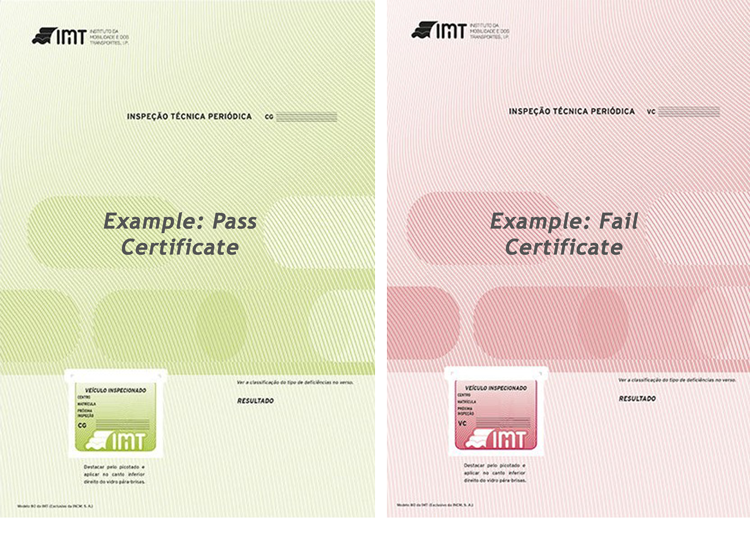
M06E - Roadworthiness Inspection & Certificate
Category : Motoring
M06E - Roadworthiness Inspection & Certificate
All vehicles over a certain age are required to undertake a roadworthiness test, (Inspecção Periódica Obrigatória, IPO). A valid test certificate must be carried with the vehicle documents. The only exception to this rule is for veteran (classics) cars, which instead should carry a certificate, proving it to be a veteran car. Veteran car certificates are issued by the Portuguese Veteran Car Club (CPAA - Clube Português de Automóveis Antigos).
The entry of periodic inspections of motorcycles, tricycles, quadricycles and trailers and semi-trailers, which was scheduled for 2025, has been postponed to January 2026, unless another alternative legal regime is approved, in which case the new deadline is not applicable.
Wherever we mention DUA, it refers to the vehicle documents whether it is Documento Único Automóvel itself or the older Livrete and Registo de Propriedade, depending on how long ago you registered your vehicle.
When to have your vehicle tested
The date of the first test and the frequency of subsequent tests depends on the type of vehicle you own. The type of vehicle is specified in the DUA. If it is a light passenger vehicle, DUA will show it registered as a viatura ligeira de passageiros. Light passenger cars must be tested once they reach 4-years old, again at 6 and again at 8 after that they must be tested every year. Your inspection certificate will have written on it the date that the next inspection is due. This is at the bottom of the certificate in the space for Próxima inspecção. Please note that this date states the very last day for the inspection to be done.
Other light vehicles such as pickups, mixed passenger/cargo and special vehicles (ligeiros de mercadorias, ligeiros mistos, ligeiros especiais) are first tested when they reach 2-years old and then annually. Heavy vehicles and trailers are tested annually, after eight years they are tested every six months. You can find all the categories HERE
The vehicle can be presented for inspection in the month it was first registered, up to the actual date of registration, or during the previous three months to the date, unless the existing certificate specifies the next date of test (special purpose tests).
Authorised inspection centres (Centros de Inspeção Técnica de Veículos) will carry out these tests. When a vehicle passes the inspection, the test centre will issue a green certificate (ficha de inspeção). The certificate should be carried with the other documents of the vehicle, the window sticker is no longer obligatory. Since February 2024 the mandatory use of an identification sticker for electric vehicles circulating on public roads was also eliminated.
Vehicles with serious deficiencies will be issued with a red certificate. These vehicles must be tested again within the next 30 days. Should a further test be required this must be undertaken within the next 15 days.
Vehicles with only minor deficiencies (maximum of 5) that need repairs before the next inspection date will be issued with a certificate but if stopped by the authorities can be fined if the repairs are not done.
If the car fails the test, the owner will be issued with a red provisional certificate. There are two degrees of deficiencies:
2nd degree (a maximum of 30 days is given to complete all necessary repairs
3rd degree (these vehicles cannot be driven from the inspection centre, they must be towed to a garage until repairs have been completed). Should a further test be required this must be undertaken and the test date will be indicated on the certificate issued.
Interpretation of Defects
Defects detected in inspections leading to vehicle failure are classified as:
MINOR - Classified as grade 1 in the Inspection Form, corresponds to defects that do not seriously affect the conditions of use of the vehicle or directly its safety conditions. No need for re-inspection.
SERIOUS - Classified as grade 2 in the Inspection Form, corresponds to defects that affects the conditions of use of the vehicle or directly the safety conditions, or that questions the identification of the vehicle. The vehicle must be re-inspected at the Inspection Center or at IMT, for the complete clarification of doubts regarding the identification.
VERY SERIOUS - Classified as grade 3 in the Inspection Form, corresponds to defects that implies the immobilization of the vehicle or only allows its movement to the repair site, and later return to the Inspection Centre.
What is inspected?
The tests carried out during the inspection assess the security of the vehicle to ensure that it is in a good enough condition to circulate on the public highway.
The inspection starts by confirming the vehicle identity* (model, registration number, motor and chassis numbers, and tyre sizes). There is then a series of tests that include:
level of noise, exhaust emissions, and oil leakage
lights (intensity and orientation)
body work and interior (corrosion and other damage)
visibility (mirrors, windows, and wipers)
equipment (seat belts, warning triangle, horn, speedometer)
brakes and braking power
steering and alignment
excessive play in the suspension, steering and axles
wheels and tyres
the cleaning conditions may not impair the observations during the inspection and the vehicle can fail inspection because of it
in November 2020 new maximum opacity values are introduced for diesel vehicles (exhaust gases from diesel engines) and tested
for hybrid and electric cars, the conservation status of the batteries and their compartment will be analysed, as well as the high voltage electrical circuit
Inspection of vehicle mileage, between two inspections will be carried out, in order to detect possible handling in the odometer of used cars.
When inspecting electric cars, besides the above-mentioned tests, some specific components must also be checked, namely:
Traction batteries
High voltage electrical circuits
Ground cables and ground connections
Various electrical and electronic equipment of the high voltage circuit
Safety devices
Charging system and cable
For electric vehicles if they are 100% electric, the inspection cannot consider emission levels, as they are not applicable.
Where to carry out the test
Officially, approved independent testing centres carry out the roadworthiness inspections. You can use any test centre. They are indicated by road signs marked "Centro de Inspeção Técnica de Veículos - IPO" and are listed in the yellow pages under "Automóveis - Inspecção" and on the IMT website you can download a PDF with them here by clicking on atividade 228 centros.
Tests usually need to be booked in advance, but some centres will accept casual callers.
Preparing for the inspection
The test centre will need to see the vehicle documents and will need your tax registration/fiscal number (número de contribuinte). The vehicle inspection (IPO) tariffs for 2025 have been published on the IMT website. You can find them HERE.
If the vehicle is in good condition, the only preparation needed may be a good clean to make the inspection easier to do and to allow the inspectors to confirm the identification numbers easily. Older vehicles may need more preparation.
Many garages will prepare vehicles for the inspection and even deliver and collect them from the test centre. This can be a convenient time for the annual service.
If a vehicle is driven on a public road without having been subjected to a car inspection, the driver can be punished with a fine ranging from €250.00 to €1250.00 The value increases if the vehicle circulates with passengers and/or goods. In addition, if the driver does not have the Mandatory Vehicle Inspection Certificate, he may still receive a €60.00 fine, even if he has carried out the proper inspection.
If you lose your test certificate, the testing center that performed the last test will issue a replacement upon receipt of a written request.
Source: gov.pt, IMT and ACP






